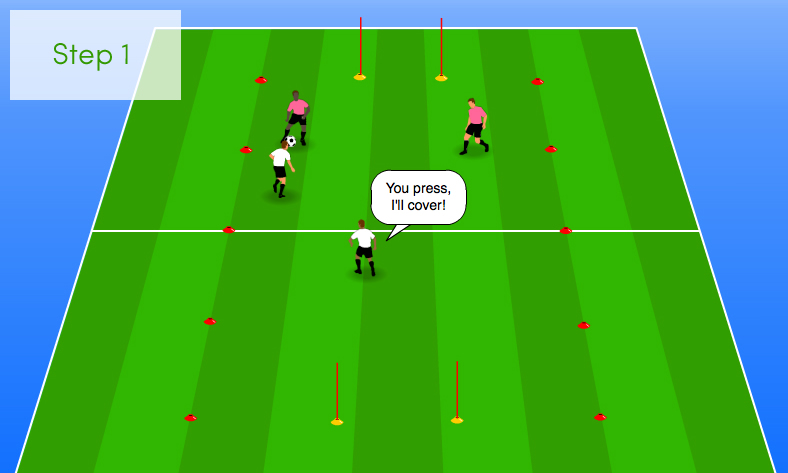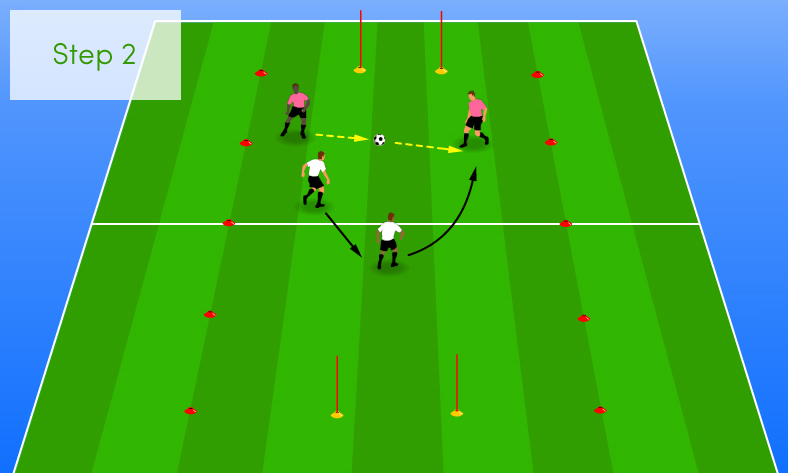2v2 Defending
- Author: Ian Knapp
- Age Group: U9 to U17+
- Time: 20 minutes
Introduction:
This practice is a natural step on from the 1v1 defending exercise. The same key points apply, but now add in working as a unit with a team mate, one pressing the ball whilst the other covers and communication between the pair to help them work more effectively. Because it's set up on a small "pitch" that involves scoring goals for the attacking team, young players generally enjoy that aspect of it, whilst allowing you to get your key defending coaching points across.
Setup:
- Set up a series of rectangular areas approximately 10 x 16 yards (but adapt for age and ability of players).
- Four players per area, split into pairs. Different colour bibs for each pair.
- One small coned gate or "goal" (poles in below diagram) at each end, in the centre. Can adapt the size of the goal to make easier / harder for defending team.
- One ball per group. Coach with more balls if required.
Basic Rules:

- One pair (attacking pair, in pink above) starts with the ball in their third, played in to them from the coach.
- The other pair (defending pair, white above) starts in their goal and can start closing down the opposition as the coach plays the pass.
- Attacking pair try to score in the goal.
- Defending pair try to stop them, with the focus on working as a unit (one presses the ball, the other covers).
- If they win the ball, defending team can attack and try to score.
- Restart once the ball goes out or a goal is scored.
- Can either rotate who is attacking / defending every turn or keep it the same for a while and then switch.


Progressions & Variations:
Introduce 3v3 defending in the same practice, with the same principals applying except now one player presses the ball and the other two drop and cover.
5 Key Coaching Points:
Remember - adapt any coaching points for the age and ability of players you're coaching. With younger players, just picking one or two simple, key things like body shape and not both rushing to the ball together for example. Don't overload the players with all the information - it won't sink in.
- Work as a team - the closest player presses the ball whilst the other covers. By "covering" we mean that the second player doesn't rush to the ball, instead dropping off to block the route to goal in case the attacker goes past the first defender or tries to shoot. See diagrams - angle between covering player and pressing player is key - too shallow and it's easy to play behind them.
- If the ball is passed to the other attacker, the roles of the defenders would usually reverse (steps 2 and 3 above) - as the ball is passed, the second, covering defender presses the ball from the front whilst the first defender drops off and covers (see notes at the end for the logic behind this).
- We want to make the attackers' play predictable. Pressing player to use body shape to "show" the attacker with the ball in the direction we want them to go - either into our team mate, onto their weaker foot or into a part of the pitch where they can't threaten our goal. Depends on position on pitch and where our covering team mate is (see notes at the end for more thoughts on this).
- Don't dive in - wait and only try to win the ball if it's there to be won.
- Communicate - if you are going to press the ball, let your team mate know they need to drop and cover you.
There are coaching points for the attacking team too, but we're focusing on defending here, so rather than confusing the issue, we'll leave them out of this session plan.
Coaching Points (FA's 4 Corners):
| Technical | Psychological |
|---|
- Work as a unit - one presses, the other covers. Generally the closest to the ball presses and the other drops and covers.
- Angle between covering and pressing players (see diagrams) - not too shallow or we leave space in behind for the attackers to easily exploit.
- Protect the goal - angle and speed of run important in doing this.
- Body shape - side on, balls of feet, crouch, arm up. NOT FLAT!
- Show the attacker away from the goal, on to their weaker foot or in to your team mate.
- If the opportunity to win the ball arises, tackle with your front foot or if the player tries to go past you, you could use your back foot to block the ball.
- Timing of the tackle
- Keep your eyes on the ball, regardless of any tricks or fancy footwork the attacker may be using.
- Once you've won the ball, can you drive forward and turn defence into attack?
|
- Decision making - is there an opportunity to win the ball or should we just hold the player up?
- Decision making - who presses, who covers?
- Adapting - if your team mate makes a mistake or the opposition do something unexpected, how can you both adapt to make sure you still protect the goal?
- Awareness - is the player left or right footed, can we show them onto their weaker foot.
- Concentration - where is the goal? Can we make sure we keep it covered as a unit.
- Anticipate the attacker's next move based on their body shape and movement.
- Confidence to go again if you were beaten last time.
|
| Physical | Social |
|---|
- Strength to hold off the attacker and win the ball.
- Speed and fitness to keep pace with the attacker if they do go past you or to make a recovering run to cover for your team mate.
- Balance and agility to tackle, recover and block
- Speed at which you close down the attacker
|
- Working as a team and covering for your team mate.
- Communication between the two players.
- Encouraging others
- Have fun!
|
 Download a printable version of this session here...
Download a printable version of this session here...